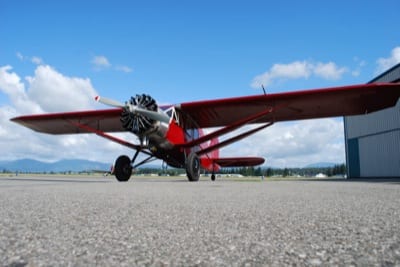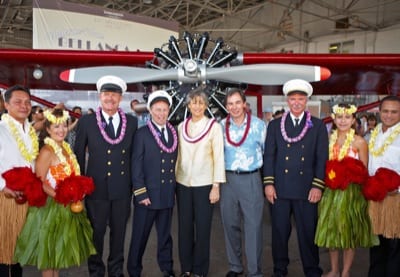 Hawaiian Airlines recently held a homecoming ceremony to welcome back the airplane that started it all for the company 80 years ago — a 1929 Bellanca CH-300 Pacemaker.
Hawaiian Airlines recently held a homecoming ceremony to welcome back the airplane that started it all for the company 80 years ago — a 1929 Bellanca CH-300 Pacemaker.
Earlier this year, the airline acquired the Bellanca, which had been grounded since 2000, from an aviation enthusiast in Oregon. The airline then initiated an ambitious restoration project at Port Townsend Aero Museum in Washington to return the plane to flying condition for the company’s 80th anniversary on Nov. 11. Support for the restoration was provided by many volunteers both from within and outside the company, and by sponsors Pratt & Whitney, manufacturer of the plane’s vintage engine, International Lease Finance Corporation, and Global Aerospace Services.
Beautifully restored, the 80-year-old airplane holds the distinction of being the only remaining Bellanca Pacemaker in the world that still flies.
The Bellanca’s history with the company was relatively brief, but its impact was overwhelmingly important to the success of Inter-Island Airways, renamed as Hawaiian Airlines in 1941, according to company officials, who note the Bellanca helped get Hawaii’s people used to the idea of traveling between the islands by air.
Company founder Stanley Kennedy acquired the Bellanca in September 1929 from the factory in Newcastle, Delaware. Kennedy believed people in Hawaii would more readily accept the revolutionary concept of air travel between the islands if they could see and experience the wonders of flight above Honolulu. To prove his faith in flying, he and family members flew on the newly purchased Bellanca from Delaware to San Francisco — a trip that took 28 hours flying time — from where it was shipped to Honolulu.
On Oct. 6, 1929, Kennedy began offering sightseeing tours over Honolulu. Piloted by Captain Sam Elliott, the company’s first pilot, the Bellanca carried 76 passengers that first day with an additional 5,000 people coming to John Rodgers Field to watch the flights.
The marketing strategy worked. On Nov. 11, 1929, the company launched scheduled air service using two Sikorsky S-38 amphibian planes that carried eight passengers and two crewmembers, and had a top cruising speed of 110 mph. The inaugural flight from Honolulu to Hilo, with a stop on Maui, took more than three hours. The first flight to Kauai was made the next day and all the islands were soon receiving air service on a regular basis. The company has been serving Hawaii continuously ever since.
The Bellanca was never used for inter-island flights. Over the next two years, 1930-31, the company continued to use the Bellanca for Honolulu sightseeing tours to help promote air travel, carrying more than 12,000 people at a cost of $3 per person.

By 1933, the Bellanca was rarely being used and, having served its intended purpose, was sold. The airplane was soon relocated to Alaska where it had a long career shipping cargo and delivering supplies to hunters and remote villages. In 1964, the plane was moved to Oregon where it remained before being acquired by Hawaiian for its return home to Hawaii.
Renowned for its endurance and distance capabilities, the single-engine Bellanca carries a pilot and five passengers and has a maximum speed of 165 mph and range of 675 miles. The plane is 8 feet, 4 inches tall, 27 feet, 9 inches long, has a wingspan of 46 feet, 4 inches, and weighs 2,275 pounds empty.
For more information: HawaiianAirlines.com or PTAeroMuseum.com.
